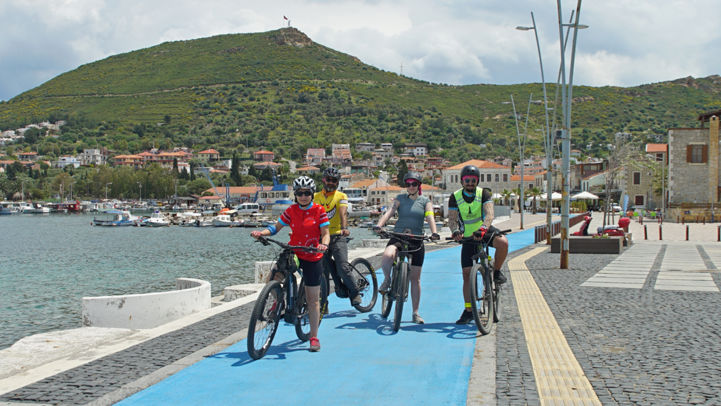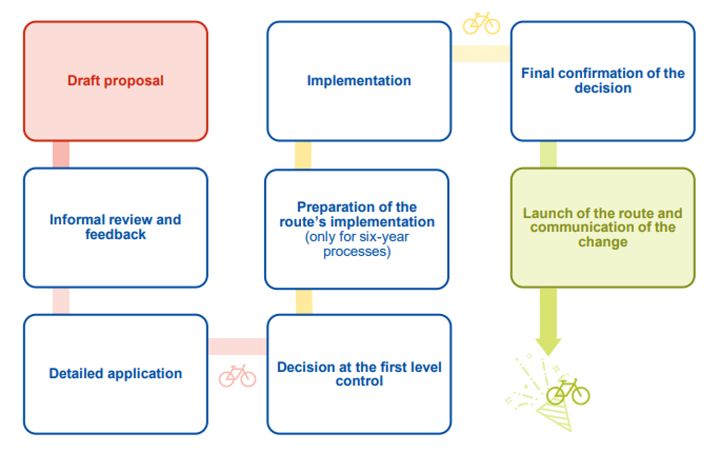Always forward: New procedure for making changes to the EuroVelo network
Every three years it is possible to apply to ECF to make a major extension to one of the existing EuroVelo routes or to add a completely new route to the network. Several major extensions and routes have joined the network in this way over the years, including EuroVelo 17 – Rhone Cycle Route, EuroVelo 19 – Meuse Cycle Route and a major extension to EuroVelo 8 – Mediterranean Route in Turkey.

The application process is set out in a document called the EuroVelo Route Coordination Rules, which has just been updated for the first time since 2016. The focus of the revision was to make this document and, by extension, the procedure easier to follow for applicants. This took into account the experiences of those routes that have followed the steps in recent years. The update also allowed for some more significant improvements to be made, as set out below.
Overview
The usual application process takes three years, but a new six-year procedure has been introduced to cater for more complex developments (see below).
As set out in the rules document, there are some basic criteria that must be fulfilled by the new route or major sections. For example, all new EuroVelo routes should cross at least two countries and be over 1,000 km long.
Following the submission of a detailed application, the route proposal will go through several phases, such as becoming a Candidate Route when approved by the EuroVelo Council at the first level control.
To ensure the quality of the new sections of the network, it will now be required that 90% of the new route’s or major section’s daily sections should meet the essential criteria of the European Certification Standard by the end of the application process. In other words, experienced cycle tourists should be able to cycle the route.
Should all the conditions be met then the route or extension will be officially added to the network and promoted through the EuroVelo channels alongside the rest of the network.

A new possibility: The six-year procedure
For routes that need to be realised ‘from scratch’, the usual three-year process may be difficult to follow. A new six-year procedure has therefore been introduced to help those routes or sections join the network, especially where it can help the development of a well-balanced EuroVelo network across Europe.
This longer process should also help to ensure the operation and quality control of the route going forward, as it will be requested that National EuroVelo Coordination Centres or Coordinators (NECC/Cs) are in place in all countries covered by the proposed new route or extension before it formally joins the network.
A well-balanced EuroVelo network
According to the EuroVelo Strategy 2030, one of the main objectives for the current decade is to improve the quality of the EuroVelo network. As a result, quality will be privileged over quantity.
However, the strategy's objectives also include encouraging the development of a more geographically balanced EuroVelo network, sharing European best practices, and bringing cycling and cycle tourism to areas less developed in this regard. The new EuroVelo Route Coordination Rules explain how this can be done.
New route applications will be encouraged and prioritised in missing capital cities and areas where there is a notable lack of EuroVelo routes at present, such as South Eastern Europe and the centre of the Iberian Peninsula.
Updated and more user-friendly guidance
With this new version of the EuroVelo Route Coordination Rules the process for adding new routes to the network or making major changes to existing routes will hopefully be easier to understand and follow by future applicants.
Submitting an application
The next deadline for submitting an application is on 31 December 2022. Draft proposals can be submitted for an initial review up to six months before the application deadline (i.e. by 30 June 2022).
There are obviously resource implications for the ECF when evaluating and (potentially) approving new and changed routes or sections, as well as for supporting new routes and major section proposals in the case of the new six-year process. The application fees have been revised to take into account the resources needed to manage the process based on recent experiences.
All the information that must be included in an application depending on the type of action, as well as the details of the costs, can be found in the EuroVelo Route Coordination Rules.
Further questions?
The EuroVelo Management Team can send the new templates to potential new route applicants. For any questions, please consult the New Routes page on the website or contact [email protected].